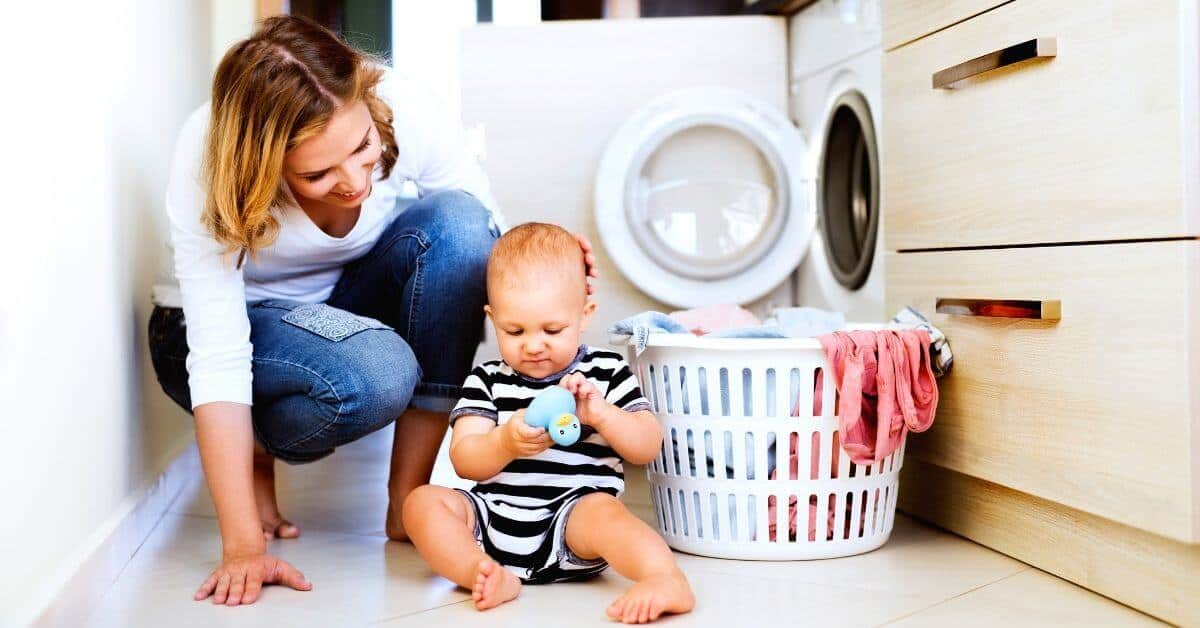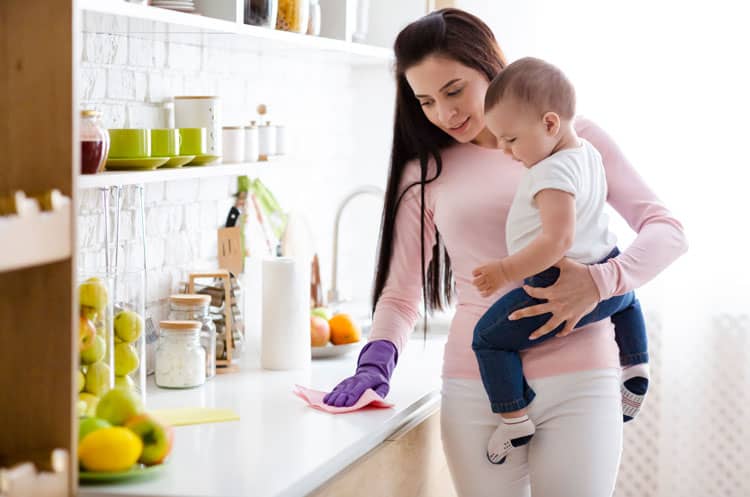Baby-safe cleaning tips
Looking for baby-safe cleaning tips?
You're not alone. With babies being 10 times more sensitive to chemical toxins than adults, finding natural and eco-friendly cleaning methods is crucial for protecting your little one. The good news is that effective, non-toxic cleaning solutions can keep your home spotless while ensuring your baby's safety and health.
Natural cleaning methods offer a safe alternative. They are effective and gentle on delicate systems. Eco-friendly cleaning solutions are not only better for your baby but also for the environment.
In this guide, we will explore baby-safe cleaning tips. You'll learn how to maintain a clean and healthy home using natural and eco-friendly methods. Let's ensure your little one's environment is as safe as it is loving.

Why Baby-Safe Cleaning Matters
Babies are inherently vulnerable to the surroundings they interact with. Their immune systems are still developing and are sensitive to toxins. Conventional cleaners often contain harsh chemicals that can irritate delicate skin and eyes.
Understanding the risk factors involved in unsafe cleaning methods is crucial for parents. Studies show that prolonged exposure to toxic chemicals can lead to respiratory issues. This makes it vital to adopt safer alternatives.
Consider these reasons for using baby-safe cleaning approaches:
- Reduces exposure to harmful chemicals
- Minimizes allergic reactions and skin irritations
- Promotes a healthier indoor environment
Switching to natural cleaning methods isn't just a trend—it's a necessity. Such practices not only safeguard your child but also support their well-being in the long run. Ensuring a toxin-free space means prioritizing your baby's health and safety above all.
Common Chemicals to Avoid Around Babies
Harmful chemicals lurk in many conventional cleaning products and are especially dangerous to infants. Frequent exposure increases the risk of respiratory problems and skin allergies. Thus, recognizing unsafe chemicals is key to ensuring your baby's safety.
Several chemicals commonly appear in household cleaners and should be avoided:
- Bleach: can cause respiratory issues and skin irritation
- Ammonia: known for its strong fumes that can irritate eyes and lungs
- Phthalates: often found in scented products, linked to hormonal issues
Avoid these substances by carefully reading product labels. Opt for unscented and non-toxic products instead. Always prioritize your child's health by choosing safe alternatives.
Consider making a checklist of harmful chemicals. This handy tool helps you navigate buying decisions more effectively. Keeping your baby's environment free from these risks is vital for their well-being. Your vigilance can make a significant difference.
Essential Natural Cleaning Methods for a Baby-Safe Home
To maintain a clean yet safe home for your baby, opt for natural cleaning methods. These are just as effective as chemical-based cleaners but without harmful effects. Simple ingredients can tackle most household messes.
Vinegar is a versatile cleaner. It disinfects surfaces, cuts through grime, and is completely non-toxic. Combine it with water for a multipurpose cleaner.
Baking soda works wonders as a scrub and deodorizer. It gently cleans without scratching surfaces. It's perfect for tackling tough stains and odors.
Consider lemon juice for its antibacterial properties. It leaves a fresh scent while naturally disinfecting. It's particularly effective for cutting through grease.
- Use a mix of vinegar and water for mopping floors
- Sprinkle baking soda on carpets to eliminate odors
For an aromatic touch, essential oils can be included. Tea tree and lavender not only smell pleasant but also possess antimicrobial properties. Use a few drops in your cleaning mix.
When cleaning, always remember to ventilate rooms. Natural ingredients still release scents. Proper airflow ensures a fresh atmosphere.

DIY Baby-Safe Cleaning Recipes
Creating your own cleaning solutions guarantees a safe, chemical-free environment. These homemade recipes are simple and require minimal effort.
A popular choice is the All-Purpose Cleaner. Mix one part vinegar with one part water. Add a few drops of essential oil for fragrance. This mix cleans countertops, mirrors, and high-touch surfaces.
For a gentle scrub, combine baking soda with water to form a paste. This scrubs sinks, bathroom tiles, and more. Apply, scrub lightly, then rinse thoroughly.
- Combine vinegar and water for a streak-free window cleaner
- Mix lemon juice and olive oil for a natural wood polish
Another effective solution is a Carpet Freshener. Sprinkle baking soda over carpets. Let sit for 15 minutes, then vacuum. It refreshes carpets, leaving them odor-free.
Additionally, a gentle dish cleaner can be crafted using castile soap. It cleans baby bottles and utensils without harsh chemicals. Always rinse thoroughly after cleaning to leave no residue.
Eco-Friendly Cleaning Products: What to Look For
Selecting eco-friendly cleaning products is essential to ensure a safe space for your little one. Look for labels indicating non-toxic ingredients. This helps avoid exposure to harmful substances.
Pay attention to certifications like Green Seal or EcoLogo. These labels confirm that products meet rigorous environmental standards. They signify a commitment to sustainability.
Natural ingredients are also important. Products based on plant-derived substances are generally safer. Consider those containing essential oils for added antibacterial properties.
- Check for clear ingredient lists
- Opt for biodegradable packaging
- Avoid artificial dyes and fragrances
When shopping, avoid products with vague labels such as "fragrance". These can mask harmful chemicals. Instead, choose items clearly labeled with transparent ingredients.

Cleaning High-Touch and Play Areas
High-touch surfaces in your home are prone to gathering germs. Regular cleaning of these areas is crucial to maintain a hygienic environment for your baby. Germs can easily transfer from these surfaces to your child.
Focus on cleaning frequently handled objects. These include doorknobs, light switches, and remote controls. Cleaning these areas reduces the chance of germ spread.
Use a damp microfiber cloth for effective dust removal. This method captures particles better than a dry cloth. Combine it with a natural disinfectant for extra cleanliness.
Toys and play areas also require special attention. Use gentle, non-toxic solutions for cleaning. Natural cleaning methods ensure your child's safety.
- Doorknobs and handles
- Light switches and remotes
- Toys and play mats
Keeping these areas clean helps create a healthier space for your baby. Regular cleaning routines minimize potential risks and give peace of mind.
Safe Cleaning for Baby Bottles, Utensils, and Feeding Areas
Cleaning baby bottles and utensils properly is essential for your child's health. Always ensure that these items are washed with safe, non-toxic cleaners. This prevents harmful chemical exposure during feeding times.
Use hot water and a natural dish soap to clean bottles and utensils. Rinse everything thoroughly to remove any soap residue. You can also sterilize bottles with boiling water or steam to eliminate bacteria.
Don't forget feeding areas like high chairs. Wipe them down with a mixture of vinegar and water after each meal. This keeps these spots free from food debris and germs.
- Wash with hot water and natural soap
- Rinse thoroughly
- Sanitize with steam or boiling water
- Clean high chairs with vinegar and water mixture
Laundry Tips for Baby Clothes and Bedding
Washing baby clothes and bedding requires gentle but effective methods. Choose a natural laundry detergent, free from harsh chemicals. This helps protect your baby's delicate skin from irritation.
Avoid using fabric softeners, as they often leave a chemical residue. Instead, add a cup of white vinegar to the rinse cycle. This will soften fabrics naturally without harsh chemicals.
Ensure to wash baby items in hot water. This kills germs and dust mites that can cause allergies. Regularly clean soft toys in the same manner to keep them fresh and safe.
- Use a natural laundry detergent
- Avoid chemical softeners; use vinegar in rinse
- Wash in hot water for germ elimination
Keeping Floors and Carpets Baby-Safe
Keeping floors clean is crucial as babies often crawl or play there. Avoid harsh chemical cleaners that may leave unsafe residues. Instead, use a mix of vinegar and water for mopping. It's simple yet effective.
For carpets, opt for steam cleaning. This method sanitizes without the need for chemicals, making it safer for your baby. Regular vacuuming with a HEPA filter also reduces allergens and keeps the environment healthy.
Reinforce safety by ensuring floor areas are free of small objects. These can pose choking hazards to curious little explorers.
- Use vinegar and water for mopping
- Opt for steam cleaning for carpets
- Vacuum with a HEPA filter regularly
Air Quality and Ventilation Tips
Maintaining air quality is crucial for your baby's health. Frequent ventilation minimizes indoor pollutants and freshens the air. Open windows daily when weather permits.
Consider adding houseplants. They naturally cleanse the air and reduce toxins. Air out rooms after using any cleaning products.
- Open windows daily
- Use houseplants for air purification
- Air out rooms after cleaning
Storing and Handling Cleaning Products Safely
Proper storage of cleaning products is essential to prevent accidents. Keep all cleaning supplies out of your child's reach.
Use child-proof latches on cabinets containing hazardous items. Always label homemade cleaning solutions clearly for easy identification.
- Store products high up or locked away
- Use child-proof latches
- Clearly label homemade cleaners
Frequently Asked Questions About Baby-Safe Cleaning
Are natural cleaning methods as effective as chemical cleaners?
Yes, many natural cleaning methods are just as effective as chemical-based cleaners. Vinegar kills 99% of bacteria, baking soda removes stains and odors, and lemon juice has natural antibacterial properties. Plus, they're safer for your baby's health.
What cleaning products should I completely avoid with a baby in the house?
Avoid products containing bleach, ammonia, phthalates, formaldehyde, and artificial fragrances. These chemicals can cause respiratory issues, skin irritation, and hormonal disruption in babies whose systems are still developing.
How often should I clean toys and high-touch surfaces?
Clean toys daily, especially those that go in your baby's mouth. High-touch surfaces like doorknobs, light switches, and play areas should be cleaned at least once daily with a natural disinfectant like diluted vinegar.
Can I make my own baby-safe cleaning products?
Absolutely! Simple ingredients like white vinegar, baking soda, and castile soap can create effective cleaning solutions. A basic all-purpose cleaner can be made with equal parts water and vinegar, plus a few drops of essential oil for scent.
Conclusion: Creating a Safe, Healthy Home for Your Baby
Implementing baby-safe cleaning tips ensures your home is both safe and nurturing. Prioritize natural cleaning methods to protect your baby's sensitive environment.
By choosing eco-friendly options, you not only protect your baby but also contribute to a healthier planet. The small steps you take today will greatly benefit your baby's tomorrow.
This post is also available in: Français (French)